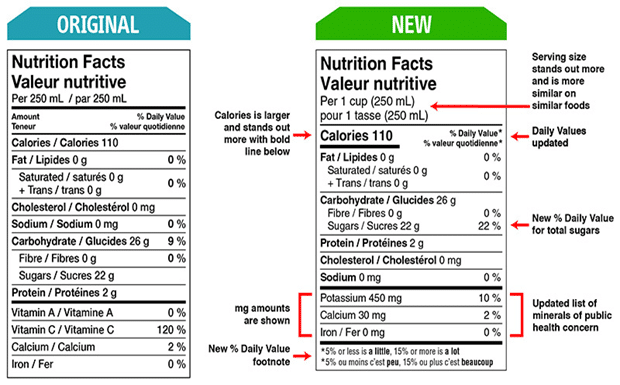The Canadian Food Inspection Agency (CFIA) protects Canadians’ health and safety by ensuring food that reaches customers is safe, nutritious, and labeled. The CFIA’s responsibilities also include enforcing federal food safety and nutrition regulations.

As of July 1, 2016, the CFIA has begun to enforce the new Nutrition Facts Table (NFT) and food labeling regulations. All food products sold in Canada must now comply with these new rules.
If you are a food manufacturer, importer, or retailer, it is crucial to understand these changes and how food labeling links your business with your customers. This blog post will provide an overview of the new NFT and food labeling requirements and some tips on how to comply with them.
Introduction to Food Safety in Canada
Food safety is a critical issue in Canada, with millions relying on the safety and quality of the food they consume daily. Ensuring that our food supply is safe and free from harmful contaminants is a complex task that involves multiple organizations and agencies at different levels of government. From farm to table, there are many steps involved in the production, processing, and distribution of food, and each of these steps must be carefully monitored and regulated to ensure the safety of our food supply.
Overview of the CFIA’s Enforcement Process
The Canadian Food Inspection Agency (CFIA) ensures that food products sold in Canada are safe and properly labeled. The CFIA enforces federal food safety and labeling laws, such as the Food and Drugs Act and the Safe Food for Canadians Act.
The CFIA’s enforcement process begins when it receives a complaint or information about a possible violation. The CFIA will then investigate to determine if there is a federal law violation. If a violation is found, the CFIA will take appropriate enforcement action, including issuing a warning, recalling a seizure order, or prosecuting the offender.
The CFIA takes food safety and labeling violations seriously and will not hesitate to take enforcement action when necessary. However, the CFIA also recognizes that many unintentional violations can be corrected quickly and easily. In these cases, the CFIA may provide guidance to help businesses comply with the law.
Nutrition Facts Table and CFIA Changes
The nutrition facts table is a mandatory component of food labels in Canada. It must be easy to read and understand and provide information on the following nutrients: calories, fat, saturated, trans fat, cholesterol, sodium, carbohydrates, fiber, sugars, and protein. The table must also include each nutrient’s percent daily value (%DV).
The %DV tells you the percentage of each nutrient in a single serving regarding the daily recommended intake. For example, if the %DV for sodium is 4%, then one serving of that food contains 4% of the daily recommended intake for sodium.
Recently, Canadian officials have made many changes to the nutrition fact table. Some of them are the following.
- Potassium has been included in the previously mentioned list of nutrients because of its significance in maintaining normal blood pressure. The majority of people in Canada do not consume sufficient amounts of this essential nutrient.
- Omit vitamin A and vitamin C because the diets of most individuals in Canada provide an adequate amount of these nutrients.
- Adding the levels of potassium, calcium, and iron that are measured in milligrams (mg)
- Including a footnote at the table’s bottom regarding the percentage of the daily value
- Consumers will have an easier time understanding how much sugar and other nutrients (like sodium) are in their meals if this information is provided, and it will explain that: A little amount would be 5% or less.
- The Nutrition Facts table can help you make wise and informed choices about the foods you eat. Use it to compare similar products and choose the one that best meets your nutritional needs.
What is the Nutrition Facts Table?
The Nutrition Facts Table is a standardized label found on most packaged foods in Canada. It provides information about the nutrient content of the food, including the number of calories, fat, protein, carbohydrates, and various vitamins and minerals. The table also includes a list of ingredients and any allergens present in the food. By using the Nutrition Facts Table, you can compare different foods and make informed choices about what you eat.
How to read the Nutrition Facts Table?
Reading the Nutrition Facts Table can be overwhelming at first, but it’s important to understand how to use it to make healthier choices. Start by looking at the serving size and the number of servings per container. This will help you understand how much of the food you are consuming. Next, look at the calories and the amount of fat, sodium, and sugar in the food. Try to choose foods that are lower in these nutrients. Finally, look at the vitamins and minerals listed in the table. Aim to choose foods that are higher in nutrients like fiber, calcium, and iron.
Food Labelling
According to the Canadian Food Inspection Agency (CFIA), food labels must include certain information to help consumers make informed choices about the foods they purchase. The CFIA is responsible for enforcing these requirements and ensuring that food labels are accurate and up-to-date.
The Nutrition Facts table is one of the most important parts of a food label, as it provides information on the nutrient content of a food. The CFIA requires that all packaged foods sold in Canada include a Nutrition Facts table on their label.
The CFIA also regulates other aspects of food labeling, such as claims about a product’s benefits, ingredient lists, and nutrition claims. For example, claims such as “low fat” or “high in fiber” must meet specific criteria for a food label.
The CFIA has published several resources to help the industry comply with food labeling requirements, including a Guide to Food Labelling and Advertising and a toolkit for small businesses.
How does the CFIA Enforce the Regulations?
The Safe Food for Canadians Act and Regulations have rules about how food labels should look. The Canadian Food Inspection Agency (CFIA) makes sure these rules are followed. The CFIA verifies that the industry complies with the regulations through various activities, such as inspections, audits, and investigations. Food Labelling Links consumers with safe food.
If the CFIA finds that a company is not in compliance with the food labeling regulations, it may take enforcement action. Enforcement actions can range from issuing a warning to ordering a recall of the products in question. The CFIA also has the authority to issue fines and prosecute companies that do not comply with the law.
The CFIA takes food labeling violations seriously and will not hesitate to take enforcement action when necessary. The industry should be aware of the Safe Food for Canadians Regulations.
What are the food label format requirements?
In Canada, certain rules must be followed when it comes to the format and presentation of food labels. Allergens must be declared in plain language, such as “contains nuts” or “made with wheat.” Nutritional facts tables also need to meet specific requirements. The table must include calories as well as serving size, nutrients listed in a specific order, relevant amounts per serving size, and a predetermined system of measurement. Any information that is not included on a label must be readily available to customers upon request.
How to ensure accurate nutrition facts are included on food labels?
To ensure accurate nutrition facts are included on food labels, it is important to use reliable sources for nutritional information. Foods that are produced commercially should include a fact table based on the manufacturer’s analysis of the product. If you’re having difficulty sourcing this information from the company, there are databases available that contain reliable nutrition facts for commonly used ingredients. It is also important to know Canadian requirements for food labeling, guidelines for declaring allergens, and other necessary facts. Additionally, any specific type of diet-related claims made on a label must adhere to the applicable regulations of Health Canada.
Where does allergen information show up on food labels?
Allergen information for food labels must be clear, concise, and consistent. This means that allergen statements should be easily visible on a product label. The presence of allergens must be indicated in the list of ingredients, at the end of the list with a statement to indicate which part of the product was used, or in the statement “contains X” near the ingredient list. In addition, precautionary statements such as “may contain X” are used when there is a potential risk of cross-contamination, although this may not always be required by law.
How to check for ingredient and product name accuracy on food labels?
When checking for the accuracy of a food label, the main thing to consider is whether the ingredients on the label match the product itself. Checking for correct spelling and including any known allergen names can help to avoid potential issues when it comes to product liability. Additionally, be sure that any additional nutritional information or claims about the product are accurate and up-to-date so that customers receive all relevant information about their purchase.
Where do lot code and method of production irregularities get displayed on food labels?
Lot codes and method of production irregularities are usually found in two places on food labels. The first is in the “Contains” or “Ingredients” section, which includes any items used to make a product. The second is in the manufacturing information, which can contain a lot of code, expiration dates, packaging facilities, and other production details. This information is particularly important if there are potential allergen risks related to a product. As such, they must be visible and accurate so that customers can identify any potential issues when selecting a product.
What are the basic Canadian food labeling requirements?
All food products must include a label that lists the common name of the food, a list of ingredients, the net quantity in metric and standard measurements, and the name and address of the company responsible for packaging or manufacturing. Product labels must also display the nutrition facts table, any warnings about potential allergens, and cooking instructions (if applicable). Additionally, fresh foods must also have a “best before” date printed on them.
How do Identify all Health Canada food Ingredients and allergens?
It is important to accurately identify all Health Canada food ingredients as well as any potential allergens. All ingredients must be listed in descending order, followed by the common name of each item. Any potential allergens must also be clearly labeled and identified on the product’s label. The Canadian Food Inspection Agency provides a comprehensive list of potential allergens that must be identified to comply with the Canadian Food and Drug Regulations.
What nutrition and serving information should be on food labels in Canada?
Food labels in Canada must list nutrition and serving information. All prepackaged foods sold in Canada must have a nutrition facts table as well as a list of ingredients. The nutrition facts table should provide information on energy, fat (including saturated fat and trans fat), cholesterol, carbohydrate, fiber, sodium, and vitamins. Serving size must also be included in the nutrition facts table, either explicitly or through reference to the amount per package.
What contact information for manufacturers is required on food labels in Canada?
All packaged foods sold in Canada must have some sort of contact information, so consumers know who to get in touch with if they have questions. This can include anything from a phone number, website address, mailing address, or email address. The contact information should be clear and easy for customers to find on the product package.
What language regulations apply to food labels in Canada?
In Canada, food labels must be bilingual. All required information, such as nutrition facts, allergen warnings, and ingredient lists, must appear both in English and French. Non-bilingual products are not allowed to be sold in the country, and any packages where these elements appear only in one language must be updated so that they meet Canadian regulations.
What is the role of the Canadian Food Inspection Agency (CFIA)?
The Canadian Food Inspection Agency (CFIA) is responsible for enforcing food safety regulations in Canada. This includes inspecting food products at various stages of production, processing, and distribution to ensure that they meet Canadian food safety standards. The CFIA also investigates foodborne illness outbreaks and works to prevent future outbreaks through education and outreach programs. In addition, the CFIA is responsible for enforcing regulations related to the labeling and advertising of food products to ensure that consumers have accurate information about the food they are purchasing and consuming.
Who are the provincial and territorial Health Authorities?
In addition to the Canadian Food Inspection Agency, provincial and territorial health authorities also play a role in enforcing food safety regulations. These organizations are responsible for inspecting food establishments within their jurisdiction, such as restaurants and grocery stores, to ensure that they are following food safety guidelines. They also investigate foodborne illness outbreaks and work with the CFIA to prevent future outbreaks. Both federal and provincial/territorial agencies need to work together to ensure the safety of Canada’s food supply.
What are the CFIA labeling requirements?
Complying with CFIA labeling requirements can be a complex process. However, there are several key requirements that all food businesses need to follow to ensure that their labeling is compliant. These include:
– Providing an accurate and complete list of ingredients: All ingredients used in the product must be listed in descending order of proportion by weight.
– Including allergen information: If the product contains any of the ten priority allergens identified by CFIA, such as peanuts, tree nuts, or soy, they must be identified on the label.
– Displaying the nutritional information: The label must include the product’s nutritional information, such as the number of calories, fat, protein, and carbohydrates per serving.
– Including the country of origin: The label must indicate the country of origin for imported food products.
– Ensuring legibility and visibility: The label must be easily readable, and all information must be prominently displayed and legible.
What are the common mistakes to avoid when labeling products?
Even with the best intentions, food businesses can make mistakes when labeling their products. These mistakes can lead to non-compliance with CFIA regulations, which can result in fines, legal issues, and reputational damage. Some common mistakes to avoid when labeling your products include:
– Failing to update labels: As regulations change, labels need to be updated to reflect the latest requirements. Failing to update labels can result in non-compliance.
– Misrepresenting the product: Labels should accurately represent the product. Misleading claims or inaccurate information can result in legal issues and reputational damage.
– Not including mandatory information: All mandatory information, such as the list of ingredients, allergen information, and nutritional information, must be included on the label.
– Using non-compliant packaging: Packaging materials must be compliant with CFIA regulations. Using non-compliant packaging can result in non-compliance and potential health risks.
Conclusion
The CFIA’s enforcement of the Nutrition Facts Table and food labeling is important in ensuring Canadians have access to accurate and up-to-date information about the foods they eat. This will help them make informed choices about the foods they purchase and ultimately lead to healthier eating habits.







